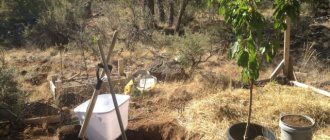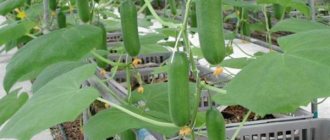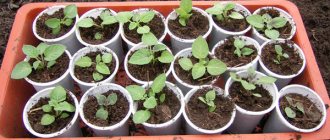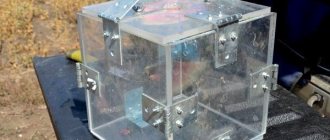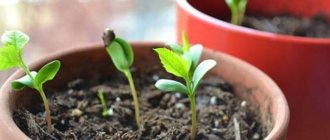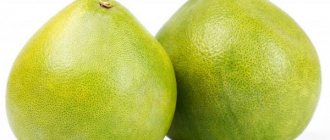Watermelon seeds
For sowing seedlings, choose early-ripening varieties that require no more than 90 days in the melon field for vegetation. These include:
- Mascot. It has bright red flesh and is very sweet. Average weight – 9–12 kg. The ripening period is 60-65 days.
- Karistan (hybrid). A very sweet variety. In the climate of the Moscow region, the fruits gain weight of 10–12 kg.
- Romanza. Mid-early variety, growing season – 55 days. Reaches up to 8 kg. Film is required for cultivation.
- Farao. Mid-early variety, ripens within 70 days. It has an unusual oblong shape. Capable of reaching a weight of up to 18 kg.
Watermelon seeds and varieties
Types and varieties of watermelon for growing on the windowsill and balcony
I will not repeat that not all varieties are suitable for home cultivation. I studied and compared the characteristics for a long time before implementing my idea. Below I will describe in the table the positive and negative features of the species.
| Variety | Characteristics | pros | Minuses |
| Sugar baby | The fruits are dark green with sweet red sugary pulp, brown seeds, grows weighing 2 -4.5 kg | strong immunity, easy to care for, ultra-early | skin up to 2 cm thick. |
| Sweet Siberian | Oval-shaped fruit with orange sweet pulp, brown seeds, light green skin with thin dark stripes, weight 2-3 kg | thin skin, early, undemanding to soil | fragile |
| Ogonyok | The fruits are round, dark green with red granular, sweet pulp, weight 1.5-3 kg | thin skin, unpretentious, disease resistant | ripens 10 days earlier than stated |
| Ultra early | Round dark green fruits with pink sweet pulp and black seeds, weight 4-6 kg | ultra-early, disease-resistant, unpretentious | thin, fragile skin |
| Scarlet sweet | The berry is light green in color with dark green stripes, weighing up to 1.6 kg | ripens 7 days earlier | dies at low temperatures |
Friends, according to the parameters, I liked the “Ultra Early” variety more; I will describe in detail how I grew a watermelon vine from seeds on the windowsill in my apartment.
When to plant watermelon seedlings
Using the lunar sowing calendar, you can optimally select the timing of seed germination and transfer of seedlings to the ground. Tips for choosing sowing dates:
- The harvest will not be the most abundant if you start germinating seeds on the new month or full moon.
- Seedlings planted on or shortly before the full moon do not grow very high.
- Planting watermelons for seedlings and transplanting into the ground is carried out with the waxing moon. Favorable days in 2021: March – 7-20, April – 6-18, May – 6-18.
Watermelon seedlings
Planting watermelon seeds occurs in April, because... Before the first autumn cold, the fruits must have time to ripen. For seedlings to take root, the sprouts must be at least 25–30 days old. Seeds germinate in 10–14 days, so seedlings are sown in mid-April on the 10th–15th.
Collection and storage of watermelons
You can start harvesting melons at the first stage of harvest maturity. Typically, this stage occurs five days before the fruit is fully ripe. If you harvest ahead of schedule, then the likelihood that the product is not ripe is high enough. And if you harvested the crop after the watermelon has ripened, then the likelihood that it will not last long also remains high.
When the harvest occurs on time, the flesh of the watermelon is pink in color and while the fruit lies, it ripens and the color of the pulp becomes redder.
In order for the product to be stored longer, it is necessary that the rind of the fruit is smooth and does not have any defects in the form of scratches, cracks, etc. How to store melons:
- Collect moss in the forest and find a box. Cover each watermelon with moss and place in a box. Remember that there can be several watermelons in a box, but they all must be protected with moss.
- You need to find a dark and cool place in the apartment. Place your harvest there. Turn it over every day.
- If you have a cellar, sprinkle straw on the racks and place watermelons on it. Also cover each watermelon with straw.
Seed preparation
The process of growing watermelon seedlings
The suitability of the seed for seedlings is checked with a salt solution - 5 g of table salt / 100 ml of water. The seed material is immersed for a few seconds - the seeds that sink to the bottom are suitable for seedlings. Technology and stages of preparing seeds for planting:
- Calibration - it is necessary to sort the seeds into small, medium and large so that when planting the seed sprouts do not crush the smaller ones.
- Scarification - the seed coat is damaged so that germination occurs faster. The procedure is recommended for regions with harsh climates.
- Warming up - seeds are poured with warm water at 50 degrees and kept for half an hour. Warming helps activate biochemical processes to stimulate growth.
- Disinfection - the seed is soaked with a weak solution of potassium permanganate for 15–20 minutes, after which the seeds are thoroughly washed with water at room temperature.
- Drying - the treated and washed seeds are kept in a nutrient solution for 10 hours. After which they are dried on the windowsill under the sun's rays.
How to select and plant seeds
First of all, you need to select the material for planting. Not every variety of watermelon can be grown at home. The seeds of delicious watermelon from the market or store are not suitable for this purpose, because this variety is grown in open areas in spring and summer. For the same reasons, varieties that are grown in dachas will not yet be suitable.
But there are hybrids that are resistant to lack of light, early ripening, and do not require special care. The following varieties are considered excellent: Ogonyok, Kaho, Sibiryak, Volgar, Gift of the Sun. They germinate very well, are tenacious, and the fruits have a sweet taste.
After purchasing, planting material must be selected before growing watermelon at home. Small and damaged seeds are excluded immediately. Large seeds are placed in a glass container containing a solution of table salt. It is done like this: 5 g of salt per 0.1 liter of water. Seeds that have sunk to the bottom must be removed, washed in water, and dried. It is these seeds that are needed for planting.
Then they are soaked in a humate solution (0.5 g per 1 liter of water). This is done as follows: gauze is wetted, in which the seeds are left for a day. This will increase germination and reduce stress. You can also leave the seeds in gauze moistened with plain water until they begin to hatch. Then the seeds need to be planted in small plastic cups, 4-5 seeds each, the earth should be slightly compacted in them.
Watering should be done in such a way that the soil is always moist. For seedlings to appear, the temperature must be about 25°C. Then shoots will begin to appear after 1 week. If the temperature is below 13°C, then seedlings may not be expected.
Cups should be in a well-lit and warm place. There is no need to allow drafts. After 2-3 weeks, you need to leave 1 seedling in each glass.
How to germinate watermelon seeds
Sprouted watermelon seeds
In order for watermelon seedlings to sprout at home, you need to germinate the seeds:
- Fill the seed with water.
- Distribute the seeds on gauze, keeping a small distance between each seed.
- Moisten the fabric with water and place in a shallow container.
- Leave in a warm room with a temperature of at least 25 degrees until the sprouts hatch.
Recommendations for gardeners
Gardening enthusiasts can grow unusual berries on their own plot (under appropriate climatic conditions).
Mold making
To make a cubic shape you will need:
- durable transparent, black polymer (polycarbonate or plexiglass) or plywood panels (sheets are possible);
- door hinges and lid lock;
- equal-flange metal corner 20-30 mm wide;
- fasteners (screws, screws, nuts, washers).
An equilateral box with a hinged lid equipped with a lock is made from the panels; the length of the side should be 20-25 cm. If the box is made in large sizes, the fruit may not grow to the required dimensions and may not acquire a cubic shape. A shape that is too small will not allow the fruit to ripen completely; the watermelon will crack during growth.
A round hole is made in the center of the lid, from which a slot is cut to place the watermelon ovary in the box. The structure must be strong enough to withstand the pressure of the growing fruit - the watermelon will tend to form a spherical shape, so the mechanical pressure on the walls of the box will be significant.
Planting and care
Seeds are planted in loosened and fertilized soil and regularly watered with warm water. The soil under watermelons should be constantly moist, watering should be carried out at least 2-3 times a day. Before planting in open ground, it is recommended to first grow seedlings at home. In this case, it is necessary to maintain a constant temperature of at least +25-28ºС.
The immaturity of watermelon does not prevent its use as decoration.
Fruit formation will begin after flowering. The berry is placed in a box after its size reaches a diameter of 8-10 cm. The form is covered from above to avoid overheating, and the bed is watered abundantly. During the ripening process, it is necessary to constantly monitor the growth of the berry. The signs of ripening in quadruple berries are the same as in regular ones:
- drying the stalk;
- tarnishing of the crust;
- the formation of a white spot at the point of contact with the surface.
Curly watermelons may not reach full maturity due to inconsistency in the size of the shape, where further growth may lead to cracking. The immaturity of watermelon does not prevent its use as decoration.
← Melon “Torpedo”: description, characteristics, useful properties ← Ideas for decorating a pumpkin for Halloween with your own hands
Caring for watermelons
Watering watermelon in loose soil
At a temperature of 25–30 degrees, the first shoots will appear within a week. You can additionally illuminate them with lamps. The first feeding is carried out after 10 days - mullein is diluted with water 1:10. The second - two weeks later. Ammonium sulfate 15 g, potassium sulfate 30 g and superphosphate 50 g are added to mullein for each liter of fertilizer.
Hardening
Before transferring the seedlings to the garden bed, it is necessary to gradually reduce the temperature by 2-3 degrees over the course of a week and reduce watering. This is necessary so that the shoots get used to outdoor conditions. For the last few days, it is better to keep the seedlings in an outdoor greenhouse or on the balcony. Before planting, water thoroughly and spray with a 1% solution of Bordeaux mixture.
Planting watermelons in open ground
Transplanting watermelon seedlings into open ground
Seedlings with 3–4 leaves should be transferred to the melon plant. The soil temperature should be at least 18 degrees. For the Moscow region this is the second ten days of June. First, humus is spread on the beds at the rate of 10 kg/m² and dug up. The planting holes are fertilized with a complex preparation for melons, heated with water, and then the seedlings are carefully transferred so as not to damage the root system.
Melons need a lot of space, so the recommended planting pattern is 50–60 cm between bushes in a row and at least two meters between rows. The seedlings are watered twice a week. 10 days after planting, the crops are fertilized with ammonium nitrate 10 g per 5 liters of water, and every 7–14 days with a solution of humus, chicken droppings or mullein with the addition of wood ash.
Plant pollination and fruit appearance
In most cases, watermelons begin to bloom 30-50 days after germination.
Flowers require pollination to produce an ovary.
To do this, you must first find male flowers that have a thin stalk. Such flowers will need to be carefully picked; they will need to be used to pollinate female flowers by touching the stamens to the pistils.
After a certain period of time, the petals will noticeably wither and the stalk will enlarge, which over time will become a fruit. As the vines grow, they will need to be pinched to stop their growth.
A few weeks before the fruits are fully ripened, watering should be minimized, stimulating the appearance of sugar in the berries. When the grown fruits are ripe, you can harvest.
